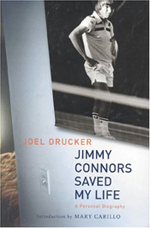Three Timeless Principles You Can
Learn from Jimmy Connors
Joel Drucker

One of the more inspirational moments I ever had with Jimmy Connors took place nearly 20 years ago. It was a spring day in 1996. He and I were walking the grounds of the famed Pebble Beach Golf Club with where Connors and John McEnroe were the headliners for a four-man senior event.
This was the early stage of the senior tour launched by Connors. There was a large crowd and plenty of excitement. Connors was comfortable and friendly as I observed him going through his public relations obligations: the Pro-Am, the celebrity lunch, the press conference.
At that point I'd already interviewed Jimmy numerous times for nearly 15 years. But that day, having just played doubles in the Pro-Am with Connors himself, I felt more like player than a mere journalist.
I asked a question that had been on my mind for several years."Jimmy," I said, "If I'd taken lessons from your mother, what would I have learned?"
Connors didn't respond. He looked away from me and stared at the Pacific Ocean. Then he turned back, leaned a foot closer to me, his hazel eyes squinting as if he was about to hit a service return. "Son," he said, "you would have learned the game."
That's all he said--like there was nothing more that needed to be said. The game. It was left for me to ponder what that meant to Jimmy and Gloria. And so I have.
I thought about the distance from Pebble Beach to Connors' birthplace, East St. Louis, the distance from the concrete courts of Illinois to the grass at Wimbledon. I thought about his years of hard work and sweat, the matches in every corner of the globe, spanning 50 years of legends, from Pancho Gonzalez, McEnroe and Bjorn Borg, to Ivan Lendl and Andre Agassi.

In one sense, the way pro tennis is played today is almost unrecognizable from what it was in Connors' glory years. Graphite rackets, poly strings, 100mph forehands, massive spin, little or no serve and volley and plays that typically stand half a foot taller than Jimmy. all those have all altered the way points are built - and, perhaps, the kind of lessons players learn at all playing levels.
Was Jimmy's game still relevant in anyway? My answer is that are three timeless principles of the Connors game that still apply to everyone who picks up a racket. Those principles? Business. Attention. Faith.
Business
No one in tennis history was better than Jimmy Connors at making the most of his time on the court. Time on the court was serious. It was fun because Connors loved striking the tennis ball, but it was all business at the same time.
A key from the beginning for Connors was that Gloria kept the minutes to a minimum, but she demanded that every minute count. Connors rarely practiced longer than 60 minutes. He practiced with absolute intensity, made every second count, and left the court eager to return.

One small example occurred on a hot, sticky summer afternoon in Indianapolis. Connors and his practice partner, a young American who'd recently turned pro, had been hitting without exchanging a word. Forehand and backhand, crosscourt and crosscourt, again and again, the ball bouncing closer to the baseline than the service line.
Connors' practice partner dashed to the side of the court for a cup of water. "Man, it's hot today," he said to Connors, perhaps hoping for a respite. Still on the baseline, Connors replied: "You want to talk or you want to work?"
Every moment and every ball counted. As Connors told me another time, "If you treat every match like it's the big match, when the big match comes, you'll be ready."
Do you or players you know talk about your next vacation during the warmup? Do you chat aimlessly on the changeovers or between points? What you should be doing: simulating real-time conditions all the time.
Another business principle was the way Connors managed his time between points. Connors paid deliberate attention to his between point rituals and carefully managed his energy.
No matter how combustible Connors was, be it with officials, fans or opponents, he carefully reset himself after each point. If you are old enough, you can probably visualize how it looked from memory: the walk to wipe his grip with a towel, an extra bounce or two of the ball before he served, a tug of the shirtsleeve and the precise setting of his feet prior to the return.
The psychologist Jim Loehr would study this ritualized behavior of Connors and others, conclude it was a critical element in the mental game, and devise training protocols for other players to develop it. You can see how to train these rituals yourself on Tennisplayer. (Click Here.)
Hitting, practice matches, tournaments matches, tour finals, the times between points or exchanges. It was all the same to Jimmy. No matter if you're a beginner or a tour player, the first principle is to treat every moment that you are on the court with supreme focus.
Adjust
The second principle is adjustment. Fond as he was of saying he never changed his game, Connors had a visceral feel for the critical adjustment. Against an ardent net rusher, he hit plenty of lobs early in the match. Deep into a fifth set, Jimmy would come up with a surprise serve and volley.

"As long as I pay attention out there, I'll be fine," Connors once told me. He had a piranha-like ability to smell opportunity like it was blood, even if that opportunity came only once in a match. And he was always open to learning what that opportunity might be.
The night before Connors played John McEnroe in the 1982 Wimbledon final, he ran into his former coach, Pancho Segura. Segura had what he thought was an important insight.
When you hit a great low return that forces a half volley, he told Connors, move forward. Because McEnroe came in behind virtually every serve, the right return in the right situation would force him to hit the ball either short or high. If Connors was far enough in the court after making that return, he could take advantage.
At the time Jimmy had already won six matches in the tournament. How much advice did he need on how to play the final? Would most players have even listened, much less filed away that insight from a random encounter?
Had Jimmy, I wondered? The answer came four sets into the match--on a point that turned the match when it was on the verge of being out of reach.
McEnroe led two sets to one and was serving at 3-2 in the fourth set tiebreaker. McEnroe had won his last four tiebreakers in Wimbledon finals and had just blitzed Connors 7-2 in the breaker at the end of the third.
Winning the next two points on serve would take him to the brink of victory. Serving in the ad court, he hit a hard lefty serve curving into Connors' backhand. It was as if Connors had simply been waiting to put Segura's idea into practice. He drove the return inside out, short and low to McEnroe's forehand side, forcing McEnroe to play a delicate forehand half volley up the line.

After hitting the return, Connors charged forward just as Segura had suggested and ripped a backhand down the line. Although McEnroe reflexed it back Connors was on top of the ball in the air and hit a two-handed backhand volley for a winner.
It was a turning point. Instead of McEnroe serving at 4-2, it was now 3-3. Connors went on to win the tiebreaker, the fifth set and the title. One adjustment on one critical point 4 sets into a match was the difference.
Connors is remembered for his incredible emotional intensity, but his intuitive problem-solving may have been an even bigger element in his success. What can the rest of us learn from him? Pay attention. Be flexible. Every opponent is different. You may have to wait for critical opportunities against different opponents. At a critical time they can reverse outcomes.
Faith
The third principle is faith. Jimmy Connors had faith in himself to hit the shot that needed to be hit, at the time it needed to be hit, even when a specific stroke was giving him problems.
Was Connors aware that he had weaknesses? How much did he try to come to terms with them, for example low, slow balls to his forehand? And what about his serve?
Probably, rationally, away from the heat of the battle, he knew. But in the cauldron, time and again he would strike his allegedly weaker shots with commitment.
In the 1976 US Open final, playing Borg on clay, the players split the first two sets and in the third reached 6-all. Borg had four set points.
One had been earned by a Connors error on a forehand approach. Yet on all four set points, Connors struck forehand approach shots with depth and aggression. One wasa winner. The other three yielded point-ending volleys.

Here is an example of Connors having faith in his serve. In the month leading up to that same '82 Wimbledon final versus, McEnroe, Connors changed his motion, tossing the ball lower and more in front of his body. The delivery improved, but was erratic at times.
In the third set, serving at 5-4, 30-all, Connors hit two doubles faults in a row to lose the game and eventually the set. That would have finished many players, even Grand Slam champions. Amazingly, for the match Connors hit a staggering 13 double faults, as opposed to his usual one or two.
Eventually, Jimmy reached set point at 6-5 in the fourth set tiebreaker. His serve had betrayed him at a similar critical moment in the third set. He could have hit a safe serve to McEnroe's forehand. Instead he hit hard deep first serve down the middle for a service winner.
In the fifth, Connors' serve held. Not until he reached 5-4, 40-love did he serve another double-fault. But at 40-15, a serve down the middle flew off the chalk, giving Connors his first Grand Slam singles title in nearly four years.
What can all players learn from this? You can't hesitate. You have to go for the shot you need at the time you need it. You have to accept if it fails. And have the courage to hit the same shot again.
Business. Attention. Faith. Jimmy Connors showed that if you have the commitment to follow these three principles, your destiny is there for the taking. I like to think that was the timeless game Gloria Connors would have taught me.





